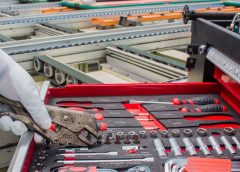In an industrial setting, conveyor belts are the backbone of any manufacturing process. They are responsible for conveying goods and materials from one point to another. A malfunctioning conveyor belt can cause a lot of downtime, hampering productivity and incurring losses.
Preventing common conveyor belt issues is crucial for running your manufacturing process at full capacity. Let’s discuss ways to prevent common conveyor belt issues and keep your manufacturing process running smoothly.
Regular Maintenance
Regular maintenance is essential to prevent conveyor belt issues. By identifying potential issues before they become bigger problems, you can save yourself a lot of headaches and expenses. Conducting routine inspections and knowing how to check the tension on your conveyor belt can help identify wear and tear, damages, or any other issues that may arise from the belt’s use. This check will help detect and prevent any issues before they become catastrophic and avoid costly downtimes.
Proper Cleaning
Cleaning the conveyor belt is essential to preventing common conveyor belt issues. Dirt, debris, and other contaminants can build up on the belt, causing damage to the belt or its components. Cleaning the conveyor belt regularly can help keep dirt and debris from getting trapped on the belt and causing damage. It is essential to use the right cleaning products as certain chemicals may cause damage to the belt.
Proper Storage
Storing conveyor belts properly is crucial to prevent damage. It is essential to store conveyor belts in a cool and dry place away from direct sunlight and extreme temperatures. Conveyor belts must be stored horizontally with minimal resistance to bending to prevent damage to a belt’s carcass. Hanging the belts can cause stretching and damage to the belt. Properly storing the conveyor belts can extend their life span and prevent damage that may cause costly downtime.
Proper Training
Proper training of employees responsible for the conveyor belt’s operation is necessary to prevent issues. You should train employees on correctly handling, operating, and maintaining conveyor belts. This training will help identify potential issues, as employees will better understand how the conveyor belt should work and what to look for to prevent issues.
Avoid Overloading
Overloading the conveyor belt can cause damage to the belt’s components or cause premature belt failure. It is essential to know the conveyor belt’s maximum load capacity and avoid overloading it. Overloading the belt can cause it to wear out faster, leading to frequent conveyor belt replacements and costly downtimes.
Conveyor belt issues can cause headaches, leading to downtime, lower productivity, and costly repairs. By following the above steps, you can prevent common conveyor belt issues, extend the life span of your conveyor belts, and keep your manufacturing process running smoothly. Regular maintenance, proper cleaning, storage, training, and avoiding overloading can go a long way in preventing conveyor belt issues. Preventing conveyor belt issues is about investing in the right maintenance and care.


